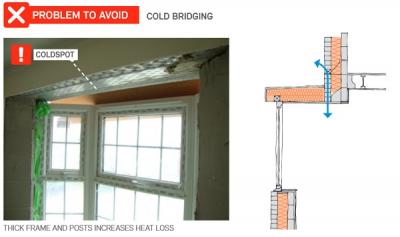Part Q – security of windows
From the 1st of October 2015 in England and from the 1st of November 2018 in Wales, Building Regulations introduced security requirements in relation to easily accessible windows in new dwellings.
Requirement Q1: security to dwellings applies only in relation to new dwellings and states that reasonable provision must be made to resist unauthorised access to any dwelling; and any part of a building from which access can be gained to a flat within the building.
In England a new dwelling is one that is erected or formed by a change of use, whilst in Wales it relates to newly erected dwellings only.
The purpose of Part Q is to make a window sufficiently robust to resist its ability to be levered open or from the glass pane being removed intact from the window frame. The aim is to make the opportunist burglar give up these means of gaining access and either leave or have to break the glass to gain entry. Breaking glass can draw attention to the burglar and takes time. This will increase the chance of them being discovered. The thief will also need to remove shards of glass to avoid injury or leaving forensic evidence behind.
Part Q security requirements for windows will be met if the window can resist physical attack by a casual or opportunist burglar. The guidance does not consider an attempted break-in by an experienced burglar who is motivated to steal because of prior knowledge of the contents in the home, uses a pre-planned method of operation and is equipped to do so.
Both versions of the Approved Document define ‘easily accessible’ as either:
- A window, any part of which is within 2m vertically of an accessible level surface such as the ground or basement level, or an access balcony; or,
- A window within 2m vertically of a flat or sloping roof (with a pitch of less than 30°) that is within 3.5m of ground level.
Because of the wording in the second point, there has been some confusion as to whether this applies to ‘any part’ of a window or only where the ‘whole window’ is within 2m.
LABC considers that it applies to ‘any part’ of a window. Once access has been gained to a flat or pitched roof the same criteria would also apply.
A burglar, in addition to arm length, would also have additional reach using a 300mm lever such as nail puller, pry bar or utility bar (test equipment used to test security) and could attack a window within this zone.
Above 2m the window is not ‘easily accessible’ as generally a ladder or similar would be needed to reach it.
Image courtesy of Westcoast Windows
Windows or rooflights in this position should be secure windows and the product should be shown to have been manufactured to a design that has been tested to an acceptable security standard and the frames mechanically fixed to the structure of the building.
The Approved Documents list the acceptable security standards.
1) PAS 24:2016 (although the 2012 version can still be used in England).
Secure windows tested to PAS 24:2012 or 2016 need to pass the tests shown in Annex C of this document or achieve level RC2N of BS EN 1627. Laboratories accredited by the United Kingdom Accreditation Service (UKAS), or an equivalent European national accreditation body should have the necessary expertise to conduct the relevant tests. However, it is not necessary to use a UKAS accredited laboratory if the testing undertaken can be shown to be fully in accordance with PAS 24. Any test evidence used to confirm the security of a window should be carefully checked to ensure that it demonstrates compliance that is adequate and that applies to the intended use.
In addition, where any window is easily accessible and has non-key locking hardware or is within 400mm of a door, the glazing requirement for windows under Part Q is satisfied if glass achieving a BS EN 356:2000 standard to a minimum of P1A is provided (typically laminate with 0.8 interlayer). The glass is tested in a horizontal test bed where a hard body impactor weighing 4.11kg is dropped onto it from a 1.5m height.
There is no specification for glass for Part Q compliance where the window is not coupled with or adjacent to a door and has locking hardware.
2) STS 204 Issue 3: 2012.
This certification is issued through Warrington Certification Limited using the Warrington Certification Security Technical Specification. There are six resistance classes with burglary ratings 1 and 2 applicable to resisting opportunist attack.
3) LPS 1175 Issue 7: 2010 security rating 1.
This certification is issued through BRE Global Limited using the relevant Loss Prevention standard. It tests the window as a system including the installation and fixing method specified by the manufacturer and makes assumptions regarding the substrate into which the window is fitted. Part Q compliance can be achieved using the lowest domestic risk classification.
4) LPS 2081 Issue 1:2015 security rating A.
This certification is again issued through BRE Global Limited using the applicable Loss Prevention standard. This LPS is like LPS 1175 but also considers an attack by an opportunist burglar with greater access to tools and greater awareness of stealth principles. Part Q compliance can be achieved using the lowest domestic risk classification.
The purpose of Part Q is to make a window sufficiently robust to resist its ability to be levered open or from the glass pane being removed intact from the window frame. The aim is to make the opportunist burglar give up these means of gaining access and either leave or have to break the glass to gain entry. Breaking glass can draw attention to the burglar and takes time. This will increase the chance of them being discovered. The thief will also need to remove shards of glass to avoid injury or leaving forensic evidence behind.
Making an opportunist thief break the glass and need to clear or climb through broken glass is considered to be a sufficient deterrent for regulatory purposes.
Please Note: Every care was taken to ensure the information was correct at the time of publication. Any written guidance provided does not replace the user’s professional judgement. It is the responsibility of the dutyholder or person carrying out the work to ensure compliance with relevant building regulations or applicable technical standards.
Sign up to the building bulletin newsletter
Over 48,000 construction professionals have already signed up for the LABC Building Bulletin.
Join them and receive useful tips, practical technical information and industry news by email once every 6 weeks.
Subscribe to the Building Bulletin







Comments
Ychwanegu sylw newydd